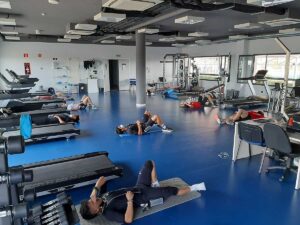Physical activity has a fundamental role in the prevention and treatment of the inconveniences associated with advanced age, such as chronic diseases, functional limitation and dependency. Postmenopausal women are associated with loss of strength and power [2] along with increased weight and fat mass [3,4], which may be due in part to decreased physical activity [5,6], and are therefore at increased risk of developing adverse outcomes for health.
High-intensity training (HIT) has been shown to be highly effective in improving physical fitness in the elderly, both in strength exercise [7,8] and endurance [9,10]. Different authors found that WB-EMS training has the same effectiveness in improving physical fitness as traditional, high-intensity resistance training without WB-EMS [11,12]. Therefore, the objective of this study is to analyze from a broad and multivariable perspective the influence of a 10-week WB-EMS training program on the physical performance of postmenopausal women.
34 postmenopausal women with no training experience were randomized into two groups. Group EX + WB-EMS (n = 17) carried out a resistance strength training program with WB-EMS superimposed, while group EX (n = 17) carried out only resistance strength training without WB-EMS.

The two groups trained with a frequency of 2 weekly sessions for 10 weeks. Between sessions, they had 48 hours of rest. The EX + WB-EMS group trained on Mondays and Thursdays, while the EX group trained on Tuesdays and Fridays.
Both groups carried out the same training program that consisted of performing cardiovascular resistance exercises and resistance strength exercises, with the difference that the EX + WB-EMS group had superimposed electrostimulation as a stimulus.
The training protocol consisted of 40-minute sessions. Participants performed a 10-minute warm-up by walking on a treadmill at a moderate speed. Subsequently, the participants carried out the resistance strength training protocol, which consisted of performing 3 multi-joint exercises such as the squat, deadlift and bench press.
The main part of this training lasted 10 minutes and was divided into 2 blocks of 5 minutes. A block consisted of 10 sets of each exercise. Each series was composed of two repetitions which were performed with 2 seconds of eccentric phase and 1 second of concentric phase (6 seconds per series). Between repetitions, 4 seconds of rest was given. Strength training was performed at 40% intensity of 1RM measured using an indirect test. The absolute load was increased by 5% every two weeks.
After the strength exercises, participants performed 10-minute cardio work on a treadmill at a constant individualized speed. Cardiovascular training intensity increased by 5% each week. In the cooldown part of the session, participants performed 10 minutes of stretching the entire body. At the end of the session, an effort perception scale was made between 6 (no effort) and 20 (maximum effort). The valuation was always close to 15.
The EX + WB-EMS group performed strength resistance training with WB-EMS superimposed. A compensated, bipolar, quadrangular current was applied with a 6-second electrical impulse duty cycle and 4-second rest with a Wiemspro electrostimulation device and suit.
During strength exercises, a frequency of 55 Hz was applied with a 60% (6 ”/ 4”) duty cycle and a pulse width: legs and glutes 350 µs, lumbar, rectus abdominis and latissimus dorsi 300 µs, trapezius 250 µs, chest 200 µs and arms 150 µs. With an entrance ramp of 800 ms and a ramp of descent of 500 ms. During cardiovascular training, a frequency of 7 Hz was applied with a continuous duty cycle. The intensity of the current was applied at a motor threshold. However, the first two weeks, moderate intensity was applied to familiarize participants with electrostimulation.
For the evaluation of this study, 8 tests were performed in which balance, leg strength, arm strength, leg flexibility, arm flexibility, agility, speed and cardiovascular endurance were measured. These tests were performed one week before the start of the training program and again one week after the end of the training program.
At the end of this study, there were no significant results in balance or in the flexibility of the upper or lower limbs. However, regarding lower / upper limb strength and speed there was a significant improvement in both groups, but there were no significant differences between the groups. On the other hand, cardiovascular resistance and agility, there was a significant improvement in the EX + WB-EMS group compared to the EX group.
Analyzing the results of this study we can say that a 10-week training program of strength and aerobic exercises applying WB-EMS with a frequency of 55 Hz and 7 Hz seems to provide positive adaptations in the dynamic strength of the legs, the speed of the gait, agility and cardiovascular endurance. However, it does not show favourable effects on the development of balance and flexibility in postmenopausal women.
BIBLIOGRAPHY
- Alvaro Pano-Rodriguez, Jose Vicente Beltran-Garrido, Vicenç Hernandez-Gonzalez and Joaquín Reverter-Masia. (2020). Effects of Whole-Body Electromyostimulation on Physical Fitness in Postmenopausal Women: A Randomized Controlled Trial. Sensors, 20, 1-16.
- Bondarev, D.; Laakkonen, E.K.; Finni, T.; Kokko, K.; Kujala, U.M.; Aukee, P.; Kovanen, V.; Sipila, S. Physical performance in relation to menopause status and physical activity. Menopause 2018, 25, 1432–1441.
- Abdulnour, J.; Doucet, E.; Brochu,M.; Lavoie, J.-M.; Strychar, I.; Rabasa-Lhoret, R.; Prud’homme, D. The effect of the menopausal transition on body composition and cardiometabolic risk factors: A Montreal-Ottawa New Emerging Team group study. Menopause 2012, 19, 760–767.
- Guthrie, J.R.; Dennerstein, L.; Dudley, E.C. Weight gain and the menopause: A 5-year prospective study. Climacteric 1999, 2, 205–211.
- Hodson, L.; Harnden, K.; Banerjee, R.; Real, B.; Marinou, K.; Karpe, F.; Fielding, B.A. Lower resting and total energy expenditure in postmenopausal compared with premenopausal women matched for abdominal obesity. J. Nutr. Sci. 2014, 3, e3.
- Duval, K.; Prud’homme, D.; Rabasa-Lhoret, R.; Strychar, I.; Brochu, M.; Lavoie, J.-M.; Doucet, E. Effects of the menopausal transition on energy expenditure: A MONET Group Study. Eur. J. Clin. Nutr. 2013, 67, 407–411.
- Lohne-Seiler, H.; Torstveit, M.K.; Anderssen, S.A. Training: Effects on Muscle Strength and Power in the Elderly. J. Aging Phys. Act. 2013, 21, 51–70.
- Rice, J.; Keogh, J.W.L. Power Training: Can it Improve Functional Performance in Older Adults? A Systematic Review. Int. J. Exerc. Sci. 2009, 2, 131–151.
- Park, J.; Han, D. Effects of high intensity aerobic exercise on treadmill on maximum-expiratory lung capacity of elderly women. J. Phys. Ther. Sci. 2017, 29, 1454–1457.
- Osuka, Y.; Matsubara, M.; Hamasaki, A.; Hiramatsu, Y.; Ohshima, H.; Tanaka, K. Development of low-volume, high-intensity, aerobic-type interval training for elderly Japanese men: A feasibility study. Eur. Rev. Aging Phys. Act. 2017, 14, 1–8.
- Kemmler,W.; Teschler, M.;Weißenfels, A.; Bebenek, M.; Fröhlich, M.; Kohl, M.; von Stengel, S.; Weissenfels, A.; Bebenek, M.; Frohlich, M.; et al. Effects of whole-body electromyostimulation versus high-intensity resistance exercise on body composition and strength: A randomized controlled study. Evid.-Based Complement. Altern. Med. 2016, 2016, 9236809.
- Kemmler, W.; Grimm, A.; Bebenek, M.; Kohl, M.; Von Stengel, S. Effects of Combined Whole-Body Electromyostimulation and Protein Supplementation on Local and Overall Muscle/Fat Distribution in Older Men with Sarcopenic Obesity: The Randomized Controlled Franconia Sarcopenic Obesity (FranSO) Study. Calcif. Tissue Int. 2018, 103, 266–277.







